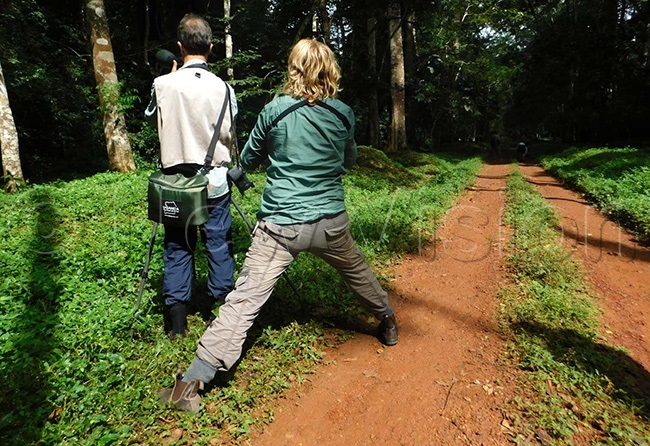Budongo gives bonus to birders
TOURISM |
The natural air conditioner of Budongo Forest which is partly delivered by the continent's biggest Mahogany tree collection in the region operates 24/7.
To celebrate the serene atmosphere in the arena comes to life with a deafening "Whom? Whom? Whom? This climaxes to an earth-shaking tree bark receiving hard slaps.
At this point, six of us on our maiden nature walk along with the Royal Mile, look at the Uganda Wildlife Authority (UWA) guide John Ogen with raised eyebrows-curious.
"That high pitched voice and hard slaps are a call by the Alpha Male (AM) Chimpanzee on his subordinates to dine," Ogen consoles us. "The message being delivered is that he has discovered a place where there are: fruits, insects, and pasture for breakfast. He is summoning his community to dine."
As we saunter deeper in the forest Ogen counts the privileges the AM enjoys. They range from exclusive mating rights, eating first, and having his coat picked off insects.
The quarter way between Nyabyeya Forest College and the Research Station, our attention switches to what we have come for, birds watching, he fishes out of his pocket a red light pointer as he fixes his eyes in the canopy 50 meters away.
"Long before COVID-19 Chimps have been keeping social distance between them and men. But they are at ease with women and children," confided Ogen. "I think this attitude is a pointer at who hurts them. To a bird watcher scouting for 300 bird species, an encounter with some of the 900 chimpanzees in Budongo is a bonus."

"All eyes at a quarter past 12:00 pm," commands Ogen in a whisper. "There is Grey African parrot posing for a photoshoot. I suspect it is wooing a female-there is a way it keeps showing off its red tail feathers. Listen to its melody."
All cameras, tripods, lenses, and sound recorders were leveled to capture every detail. Because of its beauty, the vocabulary of 20 words, and calmness, Arabs have been joined by the Chinese to cage them for prestige in their communities.
They sold at a price ranging between $500 - $2000. Hundreds have been got in transit at Entebbe International Airport and handed to Uganda Wildlife Education Center (UWEC) for medical attention before relocation to the wild.
"The biggest number received was 300 birds," recounts UWEC Ed James Musinguzi. "They were monitored by vets and animal keepers for three months. After rehabilitation and being proved healthy enough to survive in the wild, we handed them to Uganda Wildlife Authority (UWA)."
Back on the Royal Mile, Peter Wander was beaming with smiles of satisfaction as he logged his 500th species of birds logged in the last two decades.

Experience
"To me seeing the Shoebill in Mabamba was the gold medal of this trip," Tom Bird from the UK celebrates. "I have spent 10 years scouting for a shoebill in India, USA, South Africa, and Europe-my efforts were in vain. And here in Mabamba, I get it in self-quarantine!"
Peter Wander from Australia had reason to buy a round of beers for the team having clocked 2500 birds seen and photographed.
"You have to join me in the celebrations. Back home in Australia, it is not every day that you log more than 50 new different species," mused Wander. "I have seen more five different species of weaver birds, vultures and eagles. There are forest, swamp and mountain species in destination Uganda."
Meanwhile, the only lady in the group Helga Kieskamp is seen going down on all fours, climbing trees, and squinting in the sweltering noon sun heat to shoot the best of her photos in life.
"I have learned a lot from birding in Uganda," says Kieskarp. "Where else in the world do you get ladybird guides? There is some sense of security being out there in the wood with a fellow woman."
Corry Finger from the USA is appalled getting more than four different species of owls. He says besides having vibrant coloured plumage that blends with the surrounding owls are peaceful.
"These nightlife revelers are so secretive but I got them in flight, courting and feeding," smiles Finger. "I have come to the conclusion that Uganda has the world's biggest number of Kingfishers. I saw them in Entebbe, Mburo, Murchison Falls National Parks and Bwindi Impenetrable Forest."
Another American Mike Bergen sums up the birding hobby as a community that does not brag about species sighted but shares and lures others to follow suit.
"There is no age limit, victory but excitement to guide another birder to what one has spotted," said Bergen. "We cut across: religions, races, and income."
A pioneer Ugandan birder Herbert Byaruhanga says technology has changed the birding hobby in the last two decades.
"I used to master bird tweet and mimic them to attract shy ones out of the bushes," recounts Byaruhanga. "But computers have transformed everything. In the field, you no longer need a guide book but search engines to get the identity of a given bird."
What cannot be got on the computer is the physical contact with the bird and people in different destinations where cultures, cuisines, and dance styles are a bonus for any serious birder.
Getting to Budongo
To get there one can use public or private means of transport. There are minimal gate fees paid, of which 20 percent go to communities in the neighborhood.
The local government chooses how to spend the resources. It may be on feeder roads, furnishing schools or improving water availability.
It is located 30 minutes' drive from Masindi town, the accommodation available ranges between $10 a tent to $700 for bed and breakfast.
Some tourists love to sample: a traditional delicacy- Rolex, gins, and lagers that make them feel on top of the world .